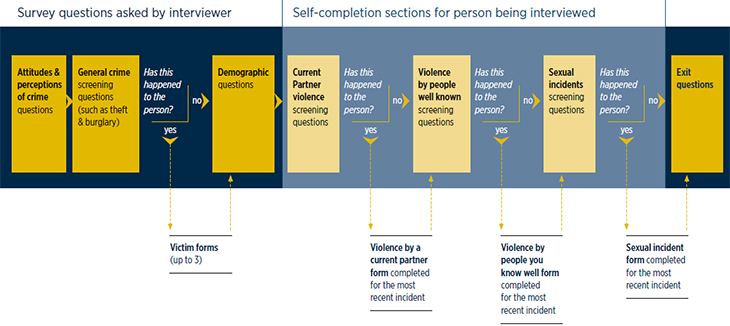Imputation
This page answers the following questions about imputation in NZCASS:
- What is imputation?
- Why is imputation done?
- How much information is imputed?
- How is the data imputed?
- What changes to imputation were made in 2014?
- How did we use imputed data in NZCASS?
What is imputation?
Imputation is a statistical method to account for missing data.
Why is imputation done?
The NZCASS questionnaire is broken into two sections, one where an interviewer asks the questions (the CAPI section) and one where the respondent answers the questions themselves (CASI section). Where someone has experienced an incident, they can complete up to three victim forms in the CAPI section and up to three victim forms in the CASI section.

Because of this design, some people won’t complete a victim form for all the incidents they’ve experienced, which means data is missing by design in NZCASS. This approach reduces respondent burden and interview length for heavily victimised respondents.
The imputation process ‘fills in’ key information about incidents not collected in the victim forms but that people told us about in the screener questions.
How much information is imputed?
In 2014, we needed imputation for 10% of respondents, which equated to 83% of incidents.
How is the data imputed?
For cases where the respondent refused or reported they did not know the number of incidents at particular screeners, the imputation process firstly imputes the number of incidents. Then the imputation process assigns the following to the incidents without victim forms:
- an offence code
- whether the incident was in scope, i.e. happened in New Zealand, in the reference period, and happened to the respondent/household personally (or their property)
- whether the incident is a duplicate of other reported incidents
- whether the victim had contact with the offender and, if so, their relationship to the offender.
What changes to imputation were made in 2014?
As part of the 2014 NZCASS, an independent quality assurance process was done to the imputation methodology and code. This process identified improvements to the 2014 imputation. We applied these improvements to the 2006 and 2009 data to make the time series consistent.
How did we use imputed data in NZCASS?
All crime rates included in the reports have been calculated using imputed data. This includes:
- the number of incidents or offences committed within a given year.
- the average number of offences per 100 households or per 100 adults (incidence rates).
- the number of households and/or adults victimised once or more.
- the percentage (%) of households or adults who were victimised once or more within a given year (prevalence rates).
We didn’t need to use imputed data for other NZCASS statistics (such as feelings of safety, lifetime experience of offences and demographics) because this data was collected completely (apart from don’t knows and refusals) in the questionnaire. Victim form data (such as reporting to Police and victim experience) also didn’t need imputed data, because the incident weights (see Weighting) took into account that information was only collected from a subset of incidents.
This page was last updated:
